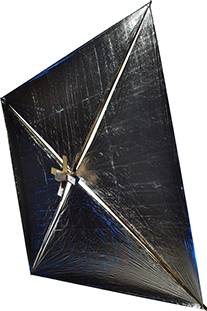Solar Sails
The next generation of space propulsion

Exploring
Solar Sails
Solar Sails | What are solar sails?
Introduction | How Solar Sails Work
Solar sails are able to function due to light. Light releases pressure that is exerted on all objects. If that light (pressure) is harnessed on a large enough surface the light's pressure can act as a propellant for the spacecraft. In other words, light contains photons, and while light has no mass, it contains momentum due to its extremely high velocity, which is the speed of light. The momentum from the photons hits a reflective surface and the force from the momentum are then transferred into the solar sails, propelling the spacecraft. Solar and/or magnetic sails may be used for both interstellar space travel, as well as, changing orbital position.

1
Definition
Solar Sails, also known as light sails, use solar/radiation pressure from stars to push extremely thin mirrors that creates a force that propels the spacecraft.
2
History
Johannes Kepler first thought of the idea of solar sails in 1610. It took many centuries and astronomers, physicists and engineers to develop the first solar sail. In 1976, the first solar sail was constructed.
3
Future Use
Solar sails are becoming increasingly popular in the aerospace industry due to their relatively cheap operating costs and long operation life.

Sail Material
Solar sails are developed from thin aluminum films, carbon fiber, alumina, and nano-tubes
CubeSat
CubeSats are small satellites shaped in a cube.